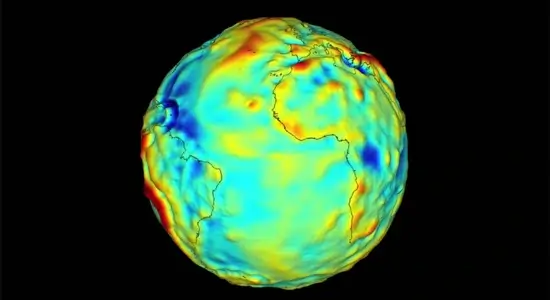 NASA’s GRACE mission created this gravity map.Image credit: NASA’s Scientific Visualization Studio
NASA’s GRACE mission created this gravity map.Image credit: NASA’s Scientific Visualization Studio
At Fact Fun, we love uncovering science stories that make us question what we know about our planet. In 2023, NASA scientists detected a 7,000-kilometer gravity anomaly stretching across the Atlantic Ocean. What made this event even stranger was its connection to a sudden magnetic phenomenon called a geomagnetic jerk, a rare occurrence where Earth’s magnetic field abruptly shifts.
What Exactly Happened?
Using satellite data, NASA tracked subtle but widespread fluctuations in Earth’s gravitational field. These variations spanned nearly 7,000 kilometers, roughly the distance from New York to Rome. Gravity anomalies usually occur when mass beneath Earth’s surface — such as mountains, trenches, or flowing molten iron — disturbs the planet’s natural balance.
In this case, however, the timing was uncanny. The gravity disturbance coincided with a geomagnetic jerk, first recognized by scientists in 1978, when Earth’s magnetic field showed sudden unexpected changes. Since then, these jerks have been observed roughly once a decade, but rarely alongside such a massive gravitational anomaly.
Why It Matters
Earth’s magnetic field protects us from harmful solar radiation and plays a critical role in navigation systems, from satellites to smartphones. A sudden jerk can temporarily disrupt satellites, communication networks, and GPS accuracy. The discovery of such a vast gravity anomaly at the same time suggests that Earth’s inner core may have played a role in triggering both effects simultaneously.
Clues From Earth’s Core
Geophysicists believe these anomalies are linked to movements deep within Earth’s molten iron core. When flows shift dramatically, they can influence both magnetism and gravity at the surface. The sheer scale of the 7,000-kilometer anomaly hints at significant processes happening far below our feet, offering scientists a rare chance to study Earth’s hidden machinery.
💡 Did You Know?
The phrase “geomagnetic jerk” was coined in 1978, but scientists now know these events recur every 10 years or so, sometimes with global consequences. What’s fascinating is how such events highlight the deep connection between gravity and magnetism.
If unusual planetary forces intrigue you, you might also enjoy reading about how the universe’s rotation may hold clues to cosmic expansion or exploring the mysterious prehistoric rituals revealed through mammoth ivory boomerangs and ancient human remains. Both stories, like this anomaly, show how surprising discoveries can reshape our understanding of science.
🌍 Curious Points About the Discovery
Q1: Could a gravity anomaly disrupt our technology?
Yes — sudden shifts in Earth’s magnetic field can affect satellites, GPS, and communication. While this anomaly poses no immediate danger, it helps scientists refine protective systems.
Q2: Why do scientists call it a “geomagnetic jerk”?
The term came from 1978, when researchers noticed sudden, sharp changes in Earth’s magnetic readings — unexpected enough to earn the “jerk” label.
Q3: What makes this 7,000 km anomaly stand out?
Its extraordinary scale, paired with its timing alongside a geomagnetic jerk, makes it one of the most remarkable Earth anomalies ever recorded.
ref : IFLscience , Nature Geoscience






